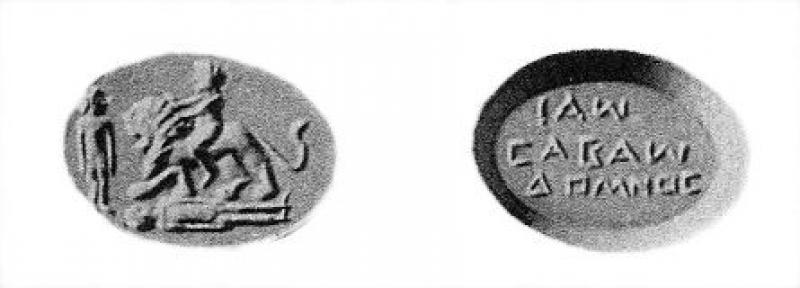Bonner, SMA, 173.
ψίκακε, the last word being doubtless a second epithet of Zeus. It is not to be found in the lexicons, but is formed on the analogy of ἀλεξίκακος, its synonym. There was a Zeus Hagios at Tripolis in Phoenicia, as coins of Julia Domna show,45 also at Gerasa (A.D. 98) and at Baitokaike (A.D. 253-259), and a Theos Hagios at Beirut (A.D. 218-222).46 The Seyrig stone, which is of Syrian origin, invokes a local Ba'al of this kind. An inscription which Zoega read frorn a curious amulet is unintelligible in its first eight lines; then follow the invocation καὶ σὺ ὁ ἔχων τὸ κρυπτὸν ὄνομα ἐν τῷiοὐρανῷ, ἅγιε Ιαωθ, and two lines made up of common magical words.47 ἅγια ὀνόματα κ‹αὶ› σύ‹μ›βολα is a phrase in the inscription of a badly corroded bronze pendant excavated at Beisan by an expedition of the University of Pennsylvania.48 In Christian terminology hagios became the regular adjective for saints.
Ενμανουηλ, together with five characters, is engraved on a stone in the Michigan collection.49 Despite the Hebrew origin of the name (Isaiah 7, 14), this might be considered a Christian amulet because the Church interpreted the words of Isaiah as a prophecy of Christ. Yet there is evidence that Emmanuel was sometimes included among the angel names,50 and it sometimes came to be treated as a mere magical word, like Ἰησοῦς, which appears after Ιαω on the Petrie bronze heart, an amulet covered on both sides with magical designs, mainly of Egyptian origin.51 Another example of Jesus as a magical word occurs in Leiden papyrus V.52 Whether Εισου is a corruption of the same name is uncertain; it is cut on the reverse of an amulet representing a lizard.53
A small yellow jasper in my possession deserves mention because of its inscription. The obverse design is a poor version of a fairly common subject (D. 241). It shows a child riding a lion, faced by a man standing stiffly with arms at his sides. Another male figure lies prostrate under the lion's feet. Although the child's head is not radiate and neither moon nor star is to be seen in the field, this is doubtless the young sun-god, and the standing man is a worshiper; on some better specimens the worshiper is a woman making the gesture of proskynesis. The prostrate man is a token of the god's victory over his enemies. The inscription on the reverse is Ιαω Σαβαω Δόμνος.
The first two words occur on countless amulets representing solar deities; the third seems to be without parallel on magical stones. It is apparently the Latin dominus, with the i omitted in colloquial pronunciation;54 but except
45 B. M. Cat. Phoenicia, pp. 214, 216.
46 Dittenberger, OGI 620, 2; 262, 26; 590, 1.
47 Museo Borgiano, p. 452, 9.
48 University of Pennsylvania Museum, No. 29.108.253 (D. 317).
50 E. Peterson, Rh. Mus., 75 (1926), 401.
51 Petrie, Amulets, 135aa; Pl. 22 also Pl. 49.
52 PGM XII, 192.
53 Seyrig 35. Ισου may be a personal name in Lefebvre, Recueil des inscr. gr. chrét. d'Égypte, 667, 8; but the text may be corrupt. See 666, 8.
54 Cf. Μερκυριω Δωμινω, CIL III, Suppl., 141622, Chalcis Syriae, 172–173 A.D.
Last modified: 2012-10-30 19:50:21
Link: cbd.mfab.hu/pandecta/1618

